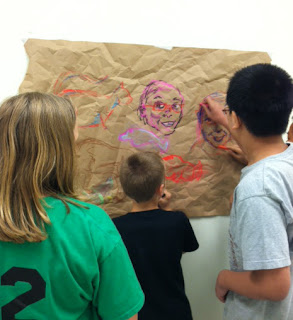(Above is an animation about how some cave paintings may have been drawn to suggest movement. By the flicker of torchlight these paintings may have seamed to almost come alive!)
Cave of Altamira, Spain
Cave of Hands, Argentina
Why did these people paint in caves? No one knows for sure. What are your ideas? Many people think it was for ritualistic purposes- hoping for a good hunt or giving thanks for a good hunt. Maybe they painted just because it's fun! Some people have speculated that they painted in caves to decorate the areas they live but it was unlikely that they lived in these caves. The areas were often very deep in the caves and hard to get to.
Lascaux Cave, France
One of the most important elements to notice in these cave paintings is how the animals are stylized. This means the artist has simplified the shapes of the animals and exaggerated their features. We know EXACTLY what these animals are at first glance, but we know that's not really what the animals look like in real life.
Chauvet Cave, France
Chauvet Cave, France
Most cave paintings represent large, wild animals. The most common types are herbivores, like dear, horses, rhinos, bison. Some caves also feature predirory animals too, like lions, bears, hyenas, and panthers. You might find cave paintings depicting people, although that's rare. Sometimes the painters make hand stencils and nonrepresentational objects like shapes, dots and lines.
To learn more about these cave paintings, check out the Ancient Craft website. Lascaux and Chauvet are some of the best known caves.
You might be inspired to make something beautiful after you learn about these paintings.
Or maybe you want to make a silly parody like these:
Check out the work my students made!!
I thought this one was really cool! I showed the kids examples of the some paintings where the artist had drawn the animals to have extra legs as possible signs of motion (as in the video at the beginning of this post) and this student added extra legs to her horse like he's trotting and bucking!
The kids likes to trace the animals in wet clay. Once these "rocks" dry they'll be able to paint them.
She made a necklace to wear her animal, traced in yarn! I like the creativity here!
Having a little too much fun, perhaps? Getting some chalk pastel on his face!
A beautiful, stylized bison, drawn just from memory!
What a cute little Zebra! :)
I added some craft paper to the wall as a little "cave wall," and after a while I noticed no one was drawing on it. I went up and drew a picture of my cat, then had a couple students volunteer to be by my models and I did quick sketches of them. Well.. apparently they weren't thrilled with how my drawings turned out. From that point, it was a mad scramble for the kids to run up to the wall and add their own little "embellishments" to the drawing.
And Friday, we learn about Matisse!






















.jpg!Blog.jpg)





